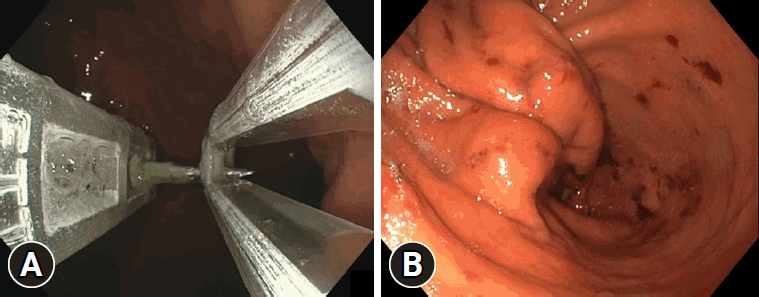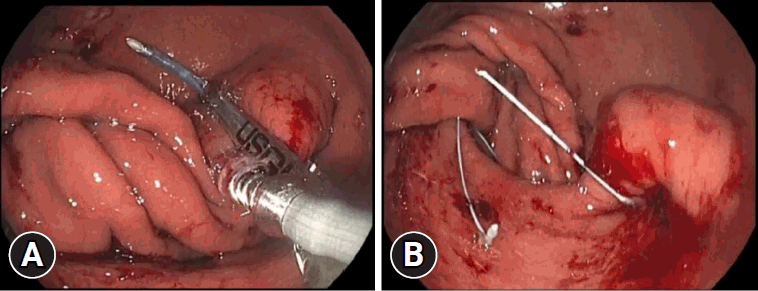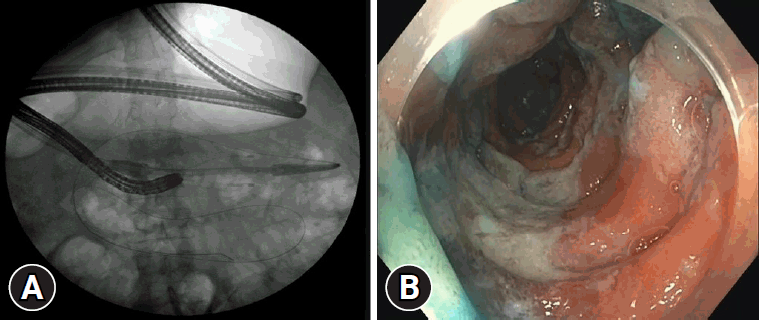2. Wharton S, Serodio KJ, Kuk JL, et al. Interest, views and perceived barriers to bariatric surgery in patients with morbid obesity. Clin Obes. 2016; 6:154–160.

3. ASGE/ASMBS Task Force on Endoscopic Bariatric Therapy, Ginsberg GG, Chand B, et al. A pathway to endoscopic bariatric therapies. Gastrointest Endosc. 2011; 74:943–953.

4. Stavrou G, Shrewsbury A, Kotzampassi K. Six intragastric balloons: which to choose? World J Gastrointest Endosc. 2021; 13:238–259.

5. Gómez V, Woodman G, Abu Dayyeh BK. Delayed gastric emptying as a proposed mechanism of action during intragastric balloon therapy: results of a prospective study. Obesity (Silver Spring). 2016; 24:1849–1853.

6. ASGE Bariatric Endoscopy Task Force and ASGE Technology Committee, Abu Dayyeh BK, Kumar N, et al. ASGE Bariatric Endoscopy Task Force systematic review and meta-analysis assessing the ASGE PIVI thresholds for adopting endoscopic bariatric therapies. Gastrointest Endosc. 2015; 82:425–438.

7. Kumar N, Bazerbachi F, Rustagi T, et al. The influence of the Orbera intragastric balloon filling volumes on weight loss, tolerability, and adverse events: a systematic review and meta-analysis. Obes Surg. 2017; 27:2272–2278.

8. Sullivan S, Swain J, Woodman G, et al. Randomized sham-controlled trial of the 6-month swallowable gas-filled intragastric balloon system for weight loss. Surg Obes Relat Dis. 2018; 14:1876–1889.

9. De Castro ML, Morales MJ, Del Campo V, et al. Efficacy, safety, and tolerance of two types of intragastric balloons placed in obese subjects: a double-blind comparative study. Obes Surg. 2010; 20:1642–1646.

10. Abu Dayyeh BK, Maselli DB, Rapaka B, et al. Adjustable intragastric balloon for treatment of obesity: a multicentre, open-label, randomised clinical trial. Lancet. 2021; 398:1965–1973.

11. Vantanasiri K, Matar R, Beran A, et al. The efficacy and safety of a procedureless gastric balloon for weight loss: a systematic review and meta-analysis. Obes Surg. 2020; 30:3341–3346.

12. Fittipaldi-Fernandez RJ, Zotarelli-Filho IJ, Diestel CF, et al. Intragastric balloon: a retrospective evaluation of 5874 patients on tolerance, complications, and efficacy in different degrees of overweight. Obes Surg. 2020; 30:4892–4898.

13. Nunes GC, Pajecki D, de Melo ME, et al. Assessment of weight loss with the intragastric balloon in patients with different degrees of obesity. Surg Laparosc Endosc Percutan Tech. 2017; 27:e83–e86.

14. Al-Sabah S, Al-Ghareeb F, Ali DA, et al. Efficacy of intragastric balloon for the management of obesity: experience from Kuwait. Surg Endosc. 2016; 30:424–429.

15. Jamal MH, Almutairi R, Elabd R, et al. The safety and efficacy of procedureless gastric balloon: a study examining the effect of elipse intragastric balloon safety, short and medium term effects on weight loss with 1-year follow-up post-removal. Obes Surg. 2019; 29:1236–1241.

16. Wiggins T, Sharma O, Sarfaraz Y, et al. Safety and efficacy of 12-month intra-gastric balloon-series of over 1100 patients. Obes Surg. 2024; 34:176–182.

17. Genco A, Bruni T, Doldi SB, et al. BioEnterics intragastric balloon: the Italian experience with 2,515 patients. Obes Surg. 2005; 15:1161–1164.

18. Busetto L, Enzi G, Inelmen EM, et al. Obstructive sleep apnea syndrome in morbid obesity: effects of intragastric balloon. Chest. 2005; 128:618–623.
19. Popov VB, Ou A, Schulman AR, et al. The impact of intragastric balloons on obesity-related co-morbidities: a systematic review and meta-analysis. Am J Gastroenterol. 2017; 112:429–439.

20. Aoko O, Maharaj T, Boland F, et al. Meta-analysis: impact of intragastric balloon therapy on NAFLD-related parameters in patients with obesity. Aliment Pharmacol Ther. 2024; 59:8–22.

21. Rinella ME, Lazarus JV, Ratziu V, et al. A multisociety Delphi consensus statement on new fatty liver disease nomenclature. Ann Hepatol. 2024; 29:101133.
22. Hedjoudje A, Abu Dayyeh BK, Cheskin LJ, et al. Efficacy and safety of endoscopic sleeve gastroplasty: a systematic review and meta-analysis. Clin Gastroenterol Hepatol. 2020; 18:1043–1053.

23. Sharaiha RZ, Kumta NA, Saumoy M, et al. Endoscopic sleeve gastroplasty significantly reduces body mass index and metabolic complications in obese patients. Clin Gastroenterol Hepatol. 2017; 15:504–510.

24. Nunes BC, de Moura DT, Kum AS, et al. Impact of endoscopic sleeve gastroplasty in non-alcoholic fatty liver disease: a systematic review and meta-analysis. Obes Surg. 2023; 33:2917–2926.

25. AlKhatry M, Rapaka B, Maselli DB, et al. Improvements in hepatic steatosis, obesity, and insulin resistance in adults with nonalcoholic fatty liver disease after the primary obesity surgery endoluminal 2.0 procedure. Endoscopy. 2023; 55:1028–1034.

26. Thompson CC, Abu Dayyeh BK, Kushner R, et al. Percutaneous gastrostomy device for the treatment of class II and class III obesity: results of a randomized controlled trial. Am J Gastroenterol. 2017; 112:447–457.

27. Jirapinyo P, de Moura DT, Horton LC, et al. Effect of aspiration therapy on obesity-related comorbidities: systematic review and meta-analysis. Clin Endosc. 2020; 53:686–697.

28. Jirapinyo P, Haas AV, Thompson CC. Effect of the duodenal-jejunal bypass liner on glycemic control in patients with type 2 diabetes with obesity: a meta-analysis with secondary analysis on weight loss and hormonal changes. Diabetes Care. 2018; 41:1106–1115.

29. Roehlen N, Laubner K, Nicolaus L, et al. Impact of duodenal-jejunal bypass liner (DJBL) on NAFLD in patients with obesity and type 2 diabetes mellitus. Nutrition. 2022; 103-104:111806.

30. de Oliveira GH, de Moura DT, Funari MP, et al. Metabolic effects of endoscopic duodenal mucosal resurfacing: a systematic review and meta-analysis. Obes Surg. 2021; 31:1304–1312.

31. van Baar AC, Beuers U, Wong K, et al. Endoscopic duodenal mucosal resurfacing improves glycaemic and hepatic indices in type 2 diabetes: 6-month multicentre results. JHEP Rep. 2019; 1:429–437.

32. Hadefi A, Verset L, Pezzullo M, et al. Endoscopic duodenal mucosal resurfacing for nonalcoholic steatohepatitis (NASH): a pilot study. Endosc Int Open. 2021; 9:E1792–E1800.

33. Machytka E, Bužga M, Zonca P, et al. Partial jejunal diversion using an incisionless magnetic anastomosis system: 1-year interim results in patients with obesity and diabetes. Gastrointest Endosc. 2017; 86:904–912.

34. Trang J, Lee SS, Miller A, et al. Incidence of nausea and vomiting after intragastric balloon placement in bariatric patients: a systematic review and meta-analysis. Int J Surg. 2018; 57:22–29.

35. Vargas EJ, Bazerbachi F, Calderon G, et al. Changes in time of gastric emptying after surgical and endoscopic bariatrics and weight loss: a systematic review and meta-analysis. Clin Gastroenterol Hepatol. 2020; 18:57–68.

36. Pontecorvi V, Bove V, Carlino G, et al. Spontaneous intragastric balloon hyperinflation is probably due to microbial overgrowth of the filling liquid. Obes Surg. 2022; 32:1783–1785.

38. Neto MG, Silva LB, Grecco E, et al. Brazilian Intragastric Balloon Consensus Statement (BIBC): practical guidelines based on experience of over 40,000 cases. Surg Obes Relat Dis. 2018; 14:151–159.

39. Dumonceau JM. Evidence-based review of the Bioenterics intragastric balloon for weight loss. Obes Surg. 2008; 18:1611–1617.

40. Turan UF, Katar MK, Ersoy PE. Factors of affecting the success of intragastric balloon. Surg Laparosc Endosc Percutan Tech. 2023; 33:141–146.

41. Tai CM, Lin HY, Yen YC, et al. Effectiveness of intragastric balloon treatment for obese patients: one-year follow-up after balloon removal. Obes Surg. 2013; 23:2068–2074.

42. Kotzampassi K, Shrewsbury AD, Papakostas P, et al. Looking into the profile of those who succeed in losing weight with an intragastric balloon. J Laparoendosc Adv Surg Tech A. 2014; 24:295–301.

43. Dogan UB, Gumurdulu Y, Akin MS, et al. Five percent weight lost in the first month of intragastric balloon treatment may be a predictor for long-term weight maintenance. Obes Surg. 2013; 23:892–896.

44. Chan DL, Cruz JR, Mui WL, et al. Outcomes with intra-gastric balloon therapy in BMI < 35 non-morbid obesity: 10-year follow-up study of an RCT. Obes Surg. 2021; 31:781–786.

45. Kotzampassi K, Grosomanidis V, Papakostas P, et al. 500 intragastric balloons: what happens 5 years thereafter? Obes Surg. 2012; 22:896–903.

46. Huberty V, Ibrahim M, Hiernaux M, et al. Safety and feasibility of an endoluminal-suturing device for endoscopic gastric reduction (with video). Gastrointest Endosc. 2017; 85:833–837.

47. Lopez-Nava G, Asokkumar R, Turró Arau R, et al. Modified primary obesity surgery endoluminal (POSE-2) procedure for the treatment of obesity. VideoGIE. 2020; 5:91–93.

48. Abu Dayyeh BK, Acosta A, Camilleri M, et al. Endoscopic sleeve gastroplasty alters gastric physiology and induces loss of body weight in obese individuals. Clin Gastroenterol Hepatol. 2017; 15:37–43.
49. Abu Dayyeh BK, Rajan E, Gostout CJ. Endoscopic sleeve gastroplasty: a potential endoscopic alternative to surgical sleeve gastrectomy for treatment of obesity. Gastrointest Endosc. 2013; 78:530–535.

50. Bove V, Gallo C, Pontecorvi V, et al. Common and uncommon problems during endoscopic suturing with Apollo overstitch: tips and tricks for troubleshooting. Tech Innov Gastrointest Endosc. 2021; 23:220–225.

51. Abu Dayyeh BK, Bazerbachi F, Vargas EJ, et al. Endoscopic sleeve gastroplasty for treatment of class 1 and 2 obesity (MERIT): a prospective, multicentre, randomised trial. Lancet. 2022; 400:441–451.

52. Sharaiha RZ, Hajifathalian K, Kumar R, et al. Five-year outcomes of endoscopic sleeve gastroplasty for the treatment of obesity. Clin Gastroenterol Hepatol. 2021; 19:1051–1057.

53. Lopez-Nava G, Laster J, Negi A, et al. Endoscopic sleeve gastroplasty (ESG) for morbid obesity: how effective is it? Surg Endosc. 2022; 36:352–360.

54. Gala K, Brunaldi V, McGowan C, et al. Performance of endoscopic sleeve gastroplasty by obesity class in the United States clinical setting. Clin Transl Gastroenterol. 2024; 15:e00647.
55. Barrichello S, Hourneaux de Moura DT, Hourneaux de Moura EG, et al. Endoscopic sleeve gastroplasty in the management of overweight and obesity: an international multicenter study. Gastrointest Endosc. 2019; 90:770–780.

56. Alqahtani A, Al-Darwish A, Mahmoud AE, et al. Short-term outcomes of endoscopic sleeve gastroplasty in 1000 consecutive patients. Gastrointest Endosc. 2019; 89:1132–1138.

57. Fehervari M, Fadel MG, Alghazawi LO, et al. Medium-term weight loss and remission of comorbidities following endoscopic sleeve gastroplasty: a systematic review and meta-analysis. Obes Surg. 2023; 33:3527–3538.

58. Huberty V, Boskoski I, Bove V, et al. Endoscopic sutured gastroplasty in addition to lifestyle modification: short-term efficacy in a controlled randomised trial. Gut. 2021; 70:1479–1485.

59. Gkolfakis P, Van Ouytsel P, Mourabit Y, et al. Weight loss after endoscopic sleeve gastroplasty is independent of suture pattern: results from a randomized controlled trial. Endosc Int Open. 2022; 10:E1245–E1253.

60. Sullivan S, Swain JM, Woodman G, et al. Randomized sham-controlled trial evaluating efficacy and safety of endoscopic gastric plication for primary obesity: the ESSENTIAL trial. Obesity (Silver Spring). 2017; 25:294–301.

61. Lopez Nava G, Arau RT, Asokkumar R, et al. Prospective multicenter study of the primary obesity surgery endoluminal (POSE 2.0) procedure for treatment of obesity. Clin Gastroenterol Hepatol. 2023; 21:81–89.

62. Lopez-Nava G, Asokkumar R, Rull A, et al. Safety and feasibility of a novel endoscopic suturing device (EndoZip TM) for treatment of obesity: first-in-human study. Obes Surg. 2020; 30:1696–1703.

63. U.S. National Library of Medicine. Evaluation of health improvement in obese patients with obesity-related comorbidities followed by EndoZip procedure (CL00010) [Internet]. U.S. National Library of Medicine;2022. [cited 2024 Jan 11]. Available from:
https://classic.clinicaltrials.gov/ct2/show/NCT05623163.
64. U.S. National Library of Medicine. Evaluation of EndoZip system in obese patients who failed to reduce weight with non-surgical weight-loss methods [Internet]. U.S. National Library of Medicine;2021. [cited 2024 Jan 11]. Available from:
https://classic.clinicaltrials.gov/ct2/show/NCT04773795.
65. Storm AC, Abu Dayyeh BK. Endoscopic sleeve gastroplasty for obesity: defining the risk and reward after more than 1600 procedures. Gastrointest Endosc. 2019; 89:1139–1140.

66. Neto MG, Silva LB, de Quadros LG, et al. Brazilian consensus on endoscopic sleeve gastroplasty. Obes Surg. 2021; 31:70–78.

67. Alqahtani A, Elahmedi M, Alqahtani YA, et al. Endoscopic sleeve gastroplasty in 109 consecutive children and adolescents with obesity: two-year outcomes of a new modality. Am J Gastroenterol. 2019; 114:1857–1862.

68. Matteo MV, Bove V, Pontecorvi V, et al. Outcomes of endoscopic sleeve gastroplasty in the elder population. Obes Surg. 2022; 32:3390–3397.

69. Lopez-Nava G, Asokkumar R, Rull A, et al. Bariatric endoscopy procedure type or follow-up: what predicted success at 1 year in 962 obese patients? Endosc Int Open. 2019; 7:E1691–E1698.

70. Salminen P, Kow L, Aminian A, et al. IFSO consensus on definitions and clinical practice guidelines for obesity management: an International Delphi Study. Obes Surg. 2024; 34:30–42.

71. Li R, Veltzke-Schlieker W, Adler A, et al. Endoscopic sleeve gastroplasty (ESG) for high-risk patients, high body mass index (> 50 kg/m
2) patients, and contraindication to abdominal surgery. Obes Surg. 2021; 31:3400–3409.

72. Fayad L, Cheskin LJ, Adam A, et al. Endoscopic sleeve gastroplasty versus intragastric balloon insertion: efficacy, durability, and safety. Endoscopy. 2019; 51:532–539.

73. Singh S, de Moura DT, Khan A, et al. Intragastric balloon versus endoscopic sleeve gastroplasty for the treatment of obesity: a systematic review and meta-analysis. Obes Surg. 2020; 30:3010–3029.

74. Sullivan S. Aspiration therapy for obesity. Gastrointest Endosc Clin N Am. 2017; 27:277–288.

76. Thompson CC, Abu Dayyeh BK, Kushnir V, et al. Aspiration therapy for the treatment of obesity: 4-year results of a multicenter randomized controlled trial. Surg Obes Relat Dis. 2019; 15:1348–1354.

78. Angelini G, Salinari S, Castagneto-Gissey L, et al. Small intestinal metabolism is central to whole-body insulin resistance. Gut. 2021; 70:1098–1109.

79. Rodriguez L, Reyes E, Fagalde P, et al. Pilot clinical study of an endoscopic, removable duodenal-jejunal bypass liner for the treatment of type 2 diabetes. Diabetes Technol Ther. 2009; 11:725–732.

80. Caiazzo R, Branche J, Raverdy V, et al. Efficacy and safety of the duodeno-jejunal bypass liner in patients with metabolic syndrome: a multicenter randomized controlled trial (ENDOMETAB). Ann Surg. 2020; 272:696–702.

81. Oh JH, Kang D, Kang W, et al. Proton pump inhibitor use increases pyogenic liver abscess risk: a nationwide cohort study. J Neurogastroenterol Motil. 2021; 27:555–564.

82. U.S. National Library of Medicine. EndoBarrier System Pivotal Trial(Rev E v2) (STEP-1) [Internet]. U.S. National Library of Medicine;2023. [cited 2024 Jan 11]. Available from:
https://clinicaltrials.gov/study/NCT04101669.
83. Mingrone G, van Baar AC, Devière J, et al. Safety and efficacy of hydrothermal duodenal mucosal resurfacing in patients with type 2 diabetes: the randomised, double-blind, sham-controlled, multicentre REVITA-2 feasibility trial. Gut. 2022; 71:254–264.

84. van Baar AC, Holleman F, Crenier L, et al. Endoscopic duodenal mucosal resurfacing for the treatment of type 2 diabetes mellitus: one year results from the first international, open-label, prospective, multicentre study. Gut. 2020; 69:295–303.

85. Rajagopalan H, Cherrington AD, Thompson CC, et al. Endoscopic duodenal mucosal resurfacing for the treatment of type 2 diabetes: 6-month interim analysis from the first-in-human proof-of-concept study. Diabetes Care. 2016; 39:2254–2261.





 PDF
PDF Citation
Citation Print
Print







 XML Download
XML Download